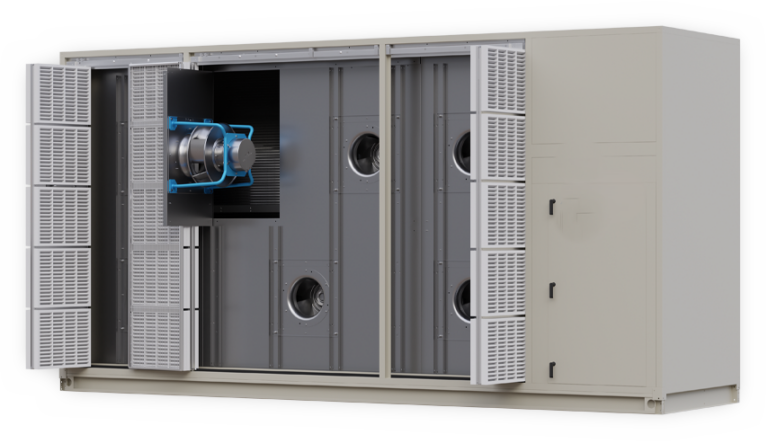Introduction
Data centers are the backbone of modern digital infrastructure, hosting servers, networking equipment, and storage devices that manage vast amounts of data. However, these electronic components generate a significant amount of heat, which, if not properly managed, can lead to overheating, system failures, and reduced equipment lifespan. To maintain optimal performance and reliability, data centers rely on chillers, which play a crucial role in regulating temperature, dissipating excess heat, and ensuring continuous operation. With the rising demand for cloud computing, artificial intelligence (AI), and high-performance computing (HPC), data centers are consuming more power than ever, making efficient cooling solutions essential. Chillers offer a cost-effective and energy-efficient way to prevent overheating while optimizing operational efficiency.
Key Factors in Data Center Cooling
- Heat Load Management
- The primary challenge in a data center is managing the heat load generated by thousands of interconnected servers and IT components.
- Excessive heat can degrade performance, shorten hardware lifespan, and lead to thermal shutdowns, causing significant disruptions.
- Chillers help dissipate this heat by circulating chilled water or air through the cooling system, ensuring that optimal temperature levels are maintained consistently.
- Precision Cooling
- Unlike traditional cooling methods, chillers provide precise temperature control, ensuring that the cooling capacity is adjusted based on real-time needs.
- Many modern data centers use variable-speed compressors that adapt cooling intensity depending on server workload fluctuations.
- Precision cooling prevents temperature fluctuations, which can lead to equipment instability and increased energy costs.
- Energy Efficiency
- Cooling accounts for nearly 40% of a data center’s total energy consumption, making efficiency a critical concern.
- Modern chillers use energy-efficient refrigerants, heat recovery systems, and free cooling technologies to reduce power consumption.
- Implementing liquid-cooled chillers instead of air-cooled alternatives can improve cooling performance while significantly lowering energy costs.
- Redundancy and Reliability
- Data centers operate 24/7, meaning that even minor cooling failures can lead to catastrophic downtime.
- Chillers are often designed with redundant cooling loops, backup pumps, and emergency power supplies to ensure continuous operation.
- A well-designed redundancy plan includes N+1, 2N, or 2N+1 configurations, where extra cooling capacity is installed to handle unexpected failures.
- Scalability
- As businesses grow, data centers must scale their infrastructure to accommodate higher processing demands.
- Chillers are available in modular configurations, allowing data centers to expand cooling capacity without disrupting existing operations.
- Scalable cooling solutions are especially beneficial for colocation data centers and hyperscale cloud providers that experience fluctuating workloads.
- Liquid Cooling vs. Air Cooling
- Air-cooled chillers:
- Use ambient air to cool refrigerant and are ideal for small to mid-sized data centers.
- Easier to install and maintain but consume more energy than water-cooled alternatives.
- Water-cooled chillers:
- Use water as the primary heat transfer medium, making them more efficient for large-scale data centers.
- Require additional cooling towers but offer better heat absorption and lower energy costs in the long run.
- The shift toward direct-to-chip and immersion cooling methods, where cooling liquid directly interacts with server components, is gaining traction in high-performance computing (HPC) applications.
- Air-cooled chillers:
Benefits of Using Chillers in Data Centers
- Prevents Equipment Overheating
- Servers operate efficiently within a specific temperature range; excessive heat can degrade performance and cause unexpected shutdowns.
- Chillers provide stable cooling, keeping all IT components at optimal operating temperatures.
- Enhances System Reliability
- Overheating can lead to hardware failures, data corruption, and increased latency in IT operations.
- With continuous cooling, chillers protect sensitive equipment from performance degradation, ensuring 99.999% uptime.
- Lowers Energy Consumption
- Energy-efficient chillers can reduce cooling-related power usage by up to 30-50%, significantly lowering operational costs.
- Using free cooling (utilizing outside air to cool water before entering the chiller system) in colder climates can further enhance energy savings.
- Improves Longevity of IT Equipment
- Consistent cooling prevents excessive wear and tear on data center hardware.
- This extends the lifespan of expensive IT equipment, reducing replacement costs over time.
- Supports Sustainability Goals
- Many data centers aim to achieve carbon neutrality by adopting energy-efficient cooling strategies.
- Water-cooled chillers reduce reliance on mechanical cooling, significantly decreasing carbon emissions.
- Ensures Compliance with Industry Standards
- Data centers must comply with regulatory standards, such as:
- ASHRAE (American Society of Heating, Refrigerating and Air-Conditioning Engineers) guidelines for temperature and humidity control.
- Uptime Institute Tier Standards, ensuring redundancy in cooling systems.
- ISO 50001 Energy Management System, which promotes energy-efficient data center practices.
- Data centers must comply with regulatory standards, such as:
Conclusion
Chillers are an integral part of modern data center infrastructure, providing reliable cooling solutions to prevent overheating, improve efficiency, and ensure continuous operation. As data centers continue to expand and consume more power, efficient cooling becomes a critical factor in reducing operational costs and maintaining sustainability. The future of data center cooling lies in liquid cooling technologies, AI-driven monitoring systems, and energy-efficient chiller designs that can dynamically adjust to workload demands. By investing in advanced cooling solutions, data centers can maximize performance, minimize downtime, and optimize energy use while supporting environmental sustainability.

